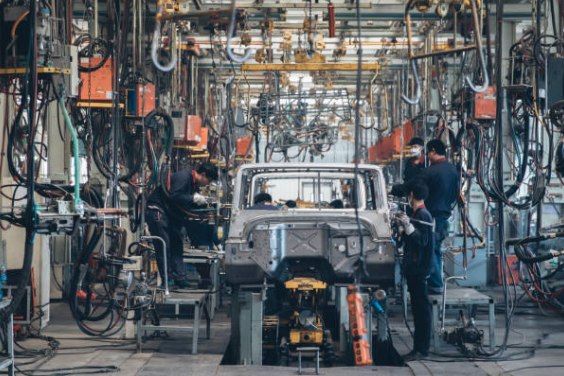Industry Solutions
- Home
- Industry Solutions
Automotive
The automotive industry is not only one of the world’s most important economic sectors by revenue, it also takes up a leading role in terms of quality expectations, product variety and process complexity. Driven by globalization and increasing customer requirements, car manufacturers are forced to offer a large range
The automotive industry is not only one of the world’s most important economic sectors by revenue, it also takes up a leading role in terms of quality expectations, product variety and process complexity. Driven by globalization and increasing customer requirements, car manufacturers are forced to offer a large range of vehicle models and options. Just for example, one single model series of a premium German automobile brand can reach 1017 possible automobile variations! The enormous product variety-induced complexity and the pressure of tough international competition make it hard to ensure efficient logistics. Automotive supply chains are among the most complex in the world, with each vehicle containing more than 20,000 parts originating from thousands of different suppliers. Add technology into the mix, and you get an industry undergoing significant transformation in a variety of ways.

of vehicle models and options. Just for example, one single model series of a premium German automobile brand can reach 1017 possible automobile variations! The enormous product variety-induced complexity and the pressure of tough international competition make it hard to ensure efficient logistics. Automotive supply chains are among the most complex in the world, with each vehicle containing more than 20,000 parts originating from thousands of different suppliers. Add technology into the mix, and you get an industry undergoing significant transformation in a variety of ways.
Challenges in Automotive Supply Chain:
- Establishing a solid presence in the world’s growth markets
- Keeping control of an international supply chain
- Being proactive in supply chain optimization
- Guaranteeing a flexible and reliable logistics chain connecting various vendors
- Supporting the industry on quality, environment and ethics
- Spare parts management

E-Commerce
In India, cash on delivery is the most preferred payment method, accumulating 75% of the e-retail activities. Demand for international consumer products (including long-tail items) is growing much faster than in-country supply from authorized distributors and e-commerce offerings. There are orders from metro cities and also far off places.
In India, cash on delivery is the most preferred payment method, accumulating 75% of the e-retail activities. Demand for international consumer products (including long-tail items) is growing much faster than in-country supply from authorised distributors and e-commerce offerings. There are orders from metro cities and also from far off places.
Increase in supply of products and lack of logistics in far off places can be a challenge for e-retailers. Few e-retailers have their own logistics network for intra-city and rely on third party services for inter-city. Others depend totally upon Third Party Service Providers (TPSP). Having warehouse at all places is also not cost effective solution. TPSP mostly use surface network to deliver the goods as this is the choice provided by e-retailers to keep their distribution cost low. Utilizing air network for delivery would be more costly.also from far off places. Increase in supply of products and lack of logistics in far off places can be a challenge for e-retailers. Few e-retailers have their own logistics network for intra-city and rely on third party services for inter-city. Others depend totally upon Third Party Service Providers (TPSP). Having warehouse at all places is also not cost effective solution. TPSP mostly use surface network to deliver the goods as this is the choice provided by e-retailers to keep their distribution cost low. Utilizing air network for delivery would be more costly.
Challenges in E-Commerce Supply Chain:
- Huge surge in the customer demand, especially during festive/special days
- Inventory Management issues by regular distributors
- Cross-border government policies, taxes and economic barriers
- Reverse logistics/Returns
- Warranties
- Micro-markets/Third and Fourth tier reach
Fashion
The global consumer spending on fashion crossed US$1.5 trillion in 2015. India’s fashion retail market is itself set to grow to US$115 billion by 2026. India’s fashion and textile industry need to recognize that the modern Indian consumer is no different from her counterparts in the west. Local brands and manufacturers
The global consumer spending on fashion crossed US$1.5 trillion in 2015. India’s fashion retail market is itself set to grow to US$115 billion by 2026.
India’s fashion and textile industry need to recognize that the modern Indian consumer is no different from her counterparts in the west. Local brands and manufacturers are crucial for enhancing India’s garments industry (Given that 75% of this market is unorganized) competitiveness.
Various innovations on digital and logistics front have catapulted the share of fashion in the purchasing pie of consumers in India over the last few years. No wonder India is being looked at as the next superpower when it comes to Fashion commerce.

are crucial for enhancing India’s garments industry (Given that 75% of this market is unorganized) competitiveness. Various innovations on digital and logistics front have catapulted the share of fashion in the purchasing pie of consumers in India over the last few years. No wonder India is being looked at as the next superpower when it comes to Fashion commerce.
Challenges in Fashion Supply Chain:
- Predicting changing styles and consumer demands
- Lost or Damaged Shipments.
- Last-mile Delivery
- Returns/Reverse shipping

Retail and Consumer
The retail sector in India is emerging as one of the largest sectors of the economy. The Indian Retail Industry, the largest among all the industries, has come forth as one of the most dynamic and fast paced industries with several players entering the market. Retail supply chain has to be monitored very closely and has to be
The retail sector in India is emerging as one of the largest sectors of the economy. The Indian Retail Industry, the largest among all the industries, has come forth as one of the most dynamic and fast paced industries with several players entering the market. Retail supply chain has to be monitored very closely and has to be free from defects as the products are always on the move and the cycle time is very low. Further the continuous movement of materials across the supply chain is crucial to the success of any organisation in the retail industry. Hence retail management is very crucial to any organisation in the retail industry and has to be monitored closely and maintained properly.
free from defects as the products are always on the move and the cycle time is very low. Further the continuous movement of materials across the supply chain is crucial to the success of any organisation in the retail industry. Hence retail management is very crucial to any organisation in the retail industry and has to be monitored closely and maintained properly.
Challenges in Retail and Consumer Supply Chain:
- Management of multiple and geographically diverse supply flows
- Supply chain cost optimization
- Reliable logistics for multi-channel distribution
- Handling of very large goods volumes
- A more responsible supply chain
- Diverse product portfolio & packaging management
Telecom
India is the world’s second-largest telecommunications market. So, we understand the complexity of this industry and the fast pace at which technology and service places demands on the Supply Chain. Major sectors of telecommunication industry are telephone, internet and television broadcast industry in the country which is in an ongoing process of
India is the world’s second-largest telecommunications market. So, we understand the complexity of this industry and the fast pace at which technology and service places demands on the Supply Chain.
Major sectors of the Indian telecommunication industry are telephone, internet and television broadcast industry in the country which is in an ongoing process of transforming into next generation network, employs an extensive system of modern network elements such as digital telephone exchanges, mobile switching centres, media gateways and signalling gateways at the core, interconnected by a wide variety of transmission systems using fibre-optics or Microwave radio relay networks.

transforming into next generation network, employs an extensive system of modern network elements such as digital telephone exchanges, mobile switching centres, media gateways and signalling gateways at the core, interconnected by a wide variety of transmission systems using fibre-optics or Microwave radio relay networks.
Challenges in Telecom Supply Chain:
- Short product lifecycles place a premium on effectively managing the launch and ramp down of products through effective demand and supply planning including end-of-life spares and replacement parts
- Lengthy and often outsourced global supply chains require coordination across geographies, accurate inventory visibility, and aligned decision-making
- Complex product structures require effective master data and supply chain processes to ensure inventory is available and obsolescence is managed
- Demand uncertainty requires balancing customer service objectives with risk and cost management goals

Pharmaceutical / Life Sciences
With a pivotal position in the global network, India’s pharmaceutical industry is poised to exceed $55 billion by 2020, according to estimates by the Associated Chambers of Commerce of India (ASSOCHAM). Facing competition from domestic and multinational
With a pivotal position in the global network, India’s pharmaceutical industry is poised to exceed $55 billion by 2020, according to estimates by the Associated Chambers of Commerce of India (ASSOCHAM). Facing competition from domestic and multinational players, India pharma companies have started to diversify and are taking bold steps to strengthen their portfolio.
A key challenges Indian organizations face is that the business differentiator is shifting from being reverse-engineering experts to having improved operational performance parameters such as service level and cost to deliver. Competition is fierce. Pressure to bring down the cost of drugs is an additional element-resulting in the need to reexamines the supply chain. Most Indian companies have successfully figured out how to reverse engineer and manufacture generic drugs but have paid little or no attention to operational aspects.
India pharma companies have started to diversify and are taking bold steps to strengthen their portfolio. A key challenges Indian organizations face is that the business differentiator is shifting from being reverse-engineering experts to having improved operational performance parameters such as service level and cost to deliver. Competition is fierce. Pressure to bring down the cost of drugs is an additional element-resulting in the need to reexamines the supply chain. Most Indian companies have successfully figured out how to reverse engineer and manufacture generic drugs but have paid little or no attention to operational aspects.
Challenges in Pharmaceutical / Life Sciences Supply Chain:
- Pharmaceutical products getting exposed to a wide range of temperature extremes during their journey.
- To create a resilient, adaptable and successful supply chain, strong coordination and effective collaboration.
- Supply chain management for clinical trials is difficult to get right.
- Awareness about the unique challenges confronting stakeholders in different locations.
Our Clients
“Our greatest asset is the customers and clients Satisfaction!” We focus on meeting clients objectives. We provide our clients with the highest quality solutions as per requirements. It’s always a pleasure to hear that we’ve done a renowned work.












